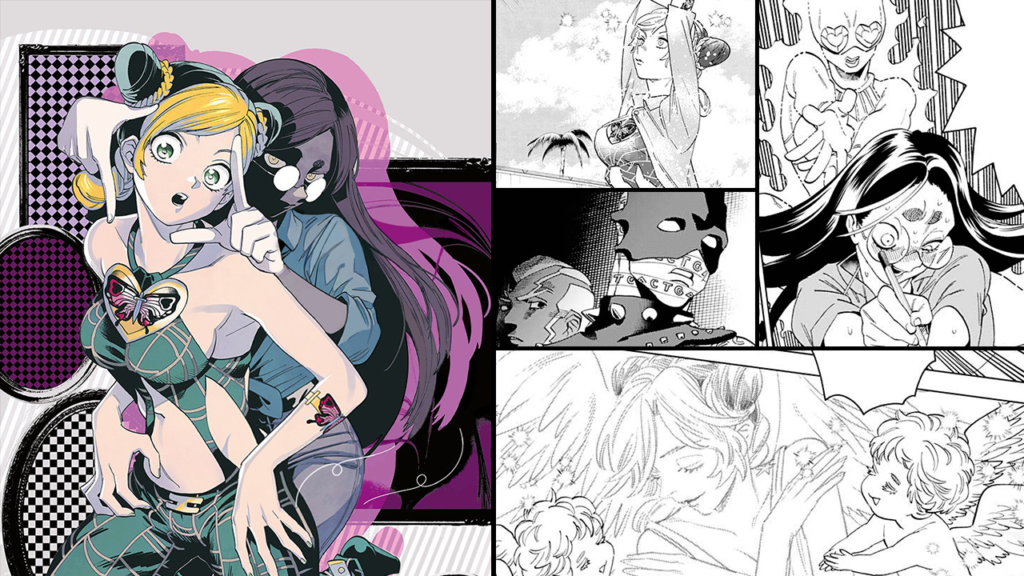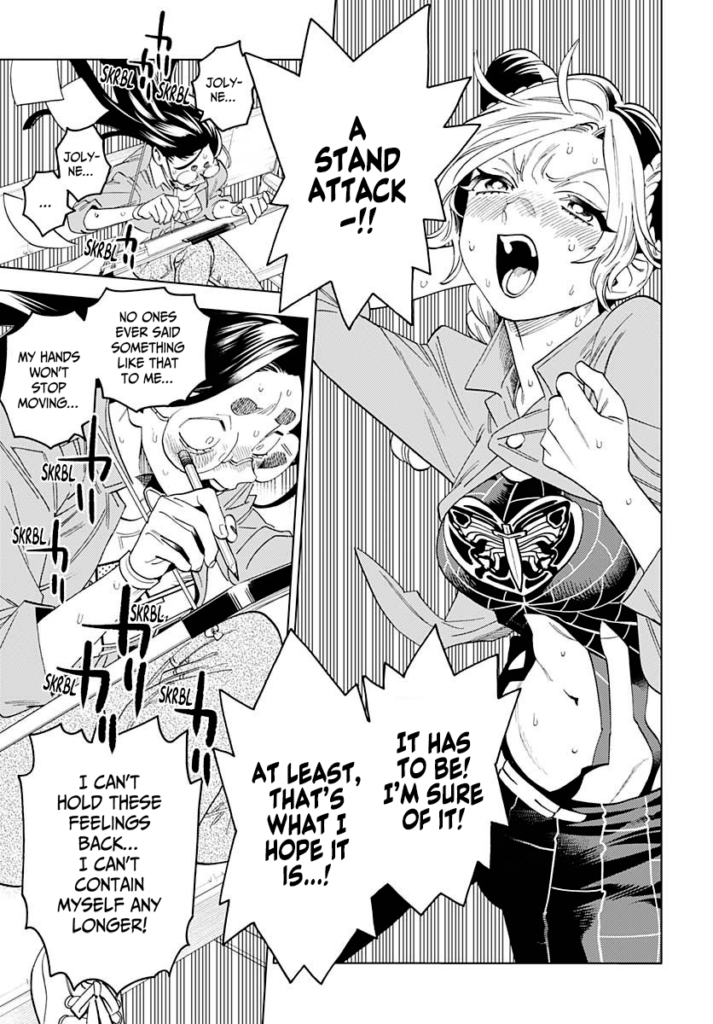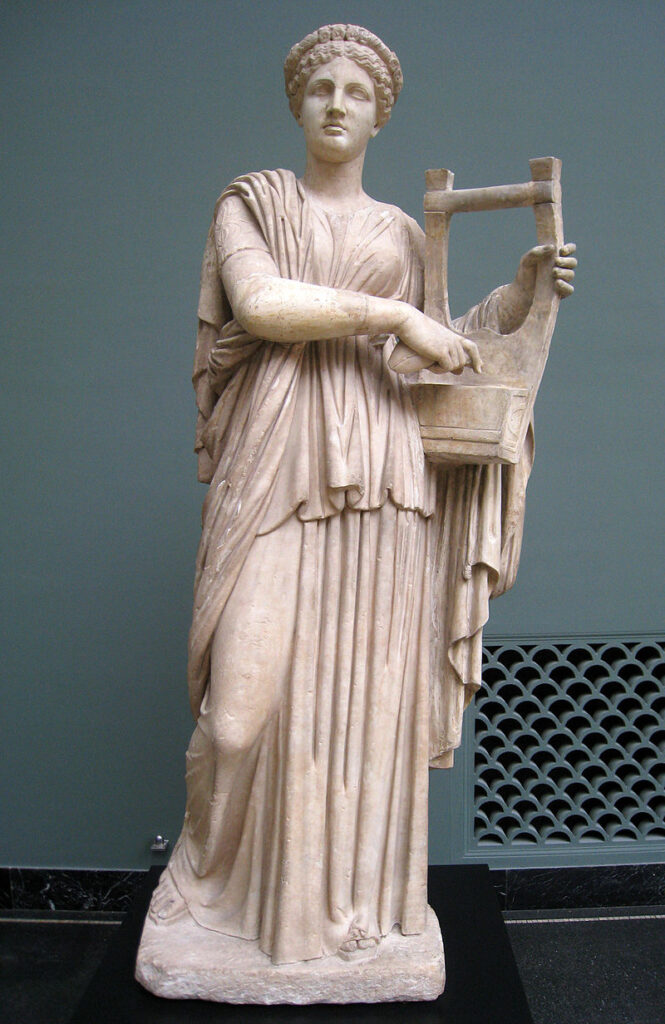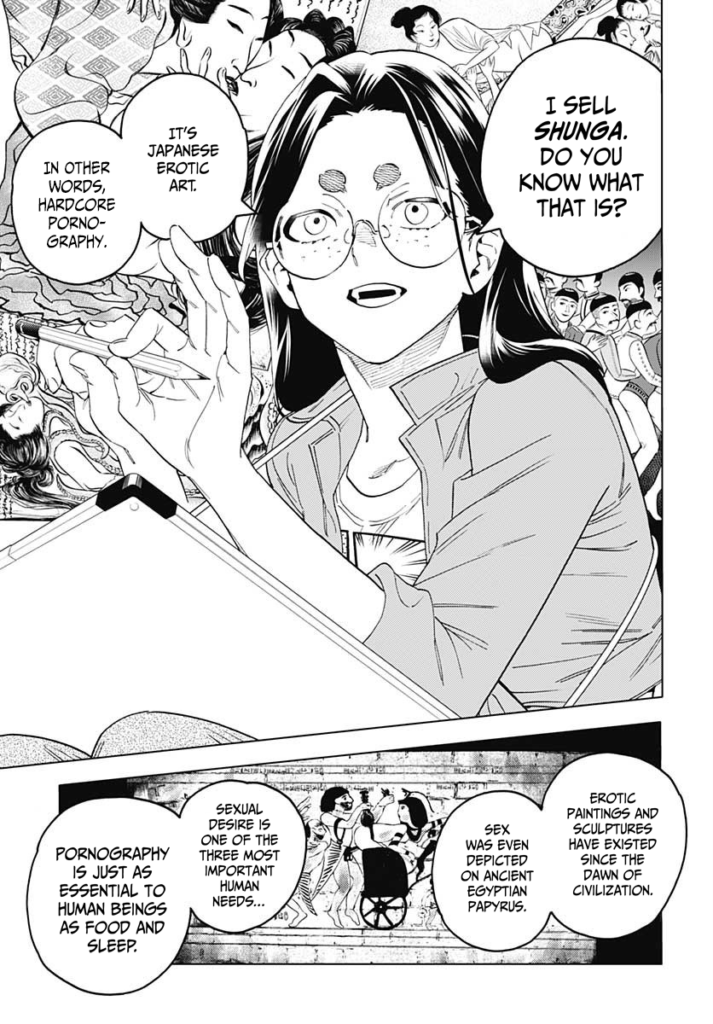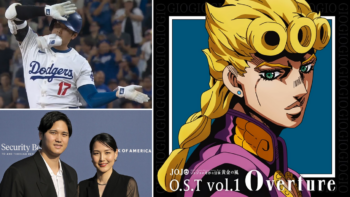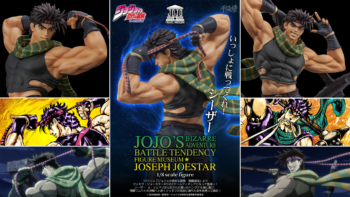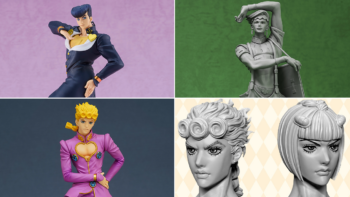“Fujiko’s Bizarre Worldly Wisdom -Whitesnake’s Miscalculation-” is a one-shot spin-off of the sixth part of JoJo’s Bizarre Adventure, Stone Ocean, written and illustrated by Sho Aimoto. This one-shot lasts 29 pages, cover included. From a plot point of view, the story is quite simple. The main antagonist Enrico Pucci seeks to control Jolyne Cujoh through the inmate and artist Fujiko Fujiyama, but a random act of kindness from Jolyne’s part causes Pucci’s plan to backfire because now Fujiko loves Jolyne. Fujiko begins to empower Jolyne instead through her art and Pucci has to stop Fujiko’s power and make her forget Jolyne. That was Pucci’s miscalculation.
The one-shot isn’t an exciting Stand fight, or a moving story, and is more of a fun, light-hearted sketch. However, even a simple and short light-hearted comedy story can be densely packed with subtext and messages. For this one-shot, Sho Aimoto has had the opportunity to think every detail thoroughly and the story reflects Aimoto’s beliefs, whether she wanted to make a statement or just because it felt right to her.
So let’s dive and see the themes and messages that are more or less hidden in this underrated one-shot.
The Value and Power of Art
Araki once said in his “Manga Technique” book that he likes titles that include the main character’s name as it shows that the manga artist cares about their protagonist. It seems like Aimoto has followed Araki’s opinion on this, as the one-shot Fujiko’s Bizarre Worldly Wisdom is centered around Fujiko Fujiyama, the title character, and not Jolyne as one may have expected.
Fujiko Fujiyama is at the core an artist. Her life revolves around the act of drawing. Through Fujiko’s character, Aimoto focuses on a number of themes around art, developing the one-shot into a justification of art.
Art Is Not Necessary but Is a Valuable Commodity
In page 12 of the one-shot, Jolyne says this when she buys Fujiko’s sketch:
It’s little things like this that truly make you feel good about yourself and put you at ease. I think that being able to enjoy stuff you don’t need is a sign of great mental composure. Maybe that’s why I need it now more than ever.
Jolyne
This phrase encapsulates what is the value of art. Strictly speaking, art is not needed to survive, but can ease one’s mind. It is not something that humans use to survive, but to thrive. Through this, Jolyne and Aimoto defend art and praise those who can appreciate it. In fact, Fujiko reacts positively and Pucci’s attack begins to backfire from this point on. Fatefully and in a karmic fashion, Jolyne’s statement ends up saving her later. By understanding the value of art, Jolyne manages to save herself.
Contrast this with the landlord who once told Fujiko to “stop wasting time with drawing and go study”. As Pucci explains, Fujiko reacted badly and stabbed him. Although this is definitely excessive, this is also a sympathetic moment for Fujiko. Drawing is not just a hobby for Fujiko, it is her passion and she’s obviously worked hard to reach her current level of drawing so of course a stranger dismissing her life’s work would make her angry.
Realities of an Artist’s Life
You might think comics draw on imagination and fantasy, but that’s wrong! To write something interesting, you have to write what you’ve seen, what you’ve done, what you’ve experienced!
Rohan Kishibe – Diamond is Unbreakable Chapter 53
Like Rohan’s iconic quote in Part 4, this one-shot interestingly shows the realities of a life as an artist, perhaps inspired by Aimoto’s own experiences. Fujiko calls herself a shunga artist and she makes a living drawing erotic commissions for other inmates, and thanks to Fujiko’s short interactions with her client, Aimoto shows some of the practicalities of an artist as a gag, which contrasts nicely with Jolyne’s behavior.
What does the client do?
- She uses money to commission a Spiderman x Deadpool pairing, a request which requires Fujiko to gather extra reference materials
- She is impatient and demanding
- She gives Fujiko extra money so that she can her get art quicker (a good fantasy for any online artists)
How does Jolyne behave?
- She pays for a mere flattering self-portrait on her own volition
- Jolyne understands the value of art
- She respected Fujiko as an artist
Through Fujiko’s client, we see that art is also a trade. Artists must sell their skills and sometimes have to create works themed around things they may not be interested in to make a living as well as dealing with less than ideal clients at times. Jolyne is at least aware of the spiritual value of art connecting people. Both the client and Jolyne enjoy their respective drawings, but Jolyne and Fujiko connect through their appreciation for art.
Art Triggers Powerful Emotions
Art is indeed valuable, but it is precious precisely because it can trigger extraordinary emotions simply by being exposed to others. This is what the one-shot’s Stand, Bad Romance, embodies. Bad Romance, has “total control over the emotions of anyone who receives one of Fujiko’s drawings”. Bad Romance is a literal representation of what art does to people, only exaggerated.
Fujiko’s usual trade showcases the power that art has over people. Her erotic drawings excite the inmates enough that they become popular and people are ready to pay a lot of money for Fujiko’s drawings. Fujiko’s art is strangely presented as an addictive thing, with prisoners dying to get their “fix” of porno.
Moreover, as Whitesnake says, “As Fujiko pours her heart into her art, [Fujiko’s victims] pour their hearts out for her”. Through this, Aimoto reveals the existence of the emotional link that art creates between the creator and their audience. Art is not just single beautiful objects that are skillfully made, but also a way for the artist to communicate with their audience. Artists invest and represent ideas and feelings through their art, and their audience resonates with these ideas and feelings.
In the one-shot, this resonance is felt through Fujiko and Jolyne’s relationship, which we are going to explore later.
Art Touches the Divine
It is said that Buddha overcame his afflictions and attained enlightenment by sitting under the Bodhi Tree. Could this Stand have given Jolyne that same kind of spiritual power?
Enrico Pucci
As the one-shot progresses, it shifts from a portrayal and defense of art to a full glorification of art. In a way, Sho Aimoto connects art with the divine. Fujiko begins to depict Jolyne in what Whitesnake calls religious drawings, in an overpositive light. This phenomenon seems justified by the mix of Fujiko’s skill but also the genuine inspiration she gets from her love for Jolyne. Jolyne has become a muse to Fujiko, and in fact, the Muses were also divinities that presided over arts. The imagery used by Fujiko evokes Heaven and its angels. Jolyne wears a pure white robe with sparkles around her, she has angel wings, and cherubs also surround her. As far as the plot is concerned, Fujiko begins to adulate Jolyne. Still, it ties with the message that art allows one to reach a superior plane, a divine plane.
As a consequence, Jolyne funnily reaches a light state of enlightenment. As the guard leading the yoga session explains, yoga was a means to reach enlightenment. But then, through Fujiko’s art and their connection, Jolyne is able to perfectly complete the yoga poses. She also happens to sparkle as well as feel good and refreshed. The story implies that it could have gone further, but Pucci puts an end to it, out of fear for this power he doesn’t understand. In a way, Jolyne almost succeeded in attaining “heaven”, which particularly angered Pucci as that’s his main goal. Unlike Jolyne who passes through her stage of emotional desire, Pucci prevents her power from growing because of his own desires.
Sexual Liberation
What has become the most infamous aspect of the one-shot is its open depiction of the characters’ sexuality. In the story, Aimoto makes a quite interesting and nuanced portrayal of sexuality in general that is worth looking into. It is actually quite fitting that Jolyne, one of the most libertine characters in the series and yet not reduced to that sexual aspect, would be the subject of a few messages about sexual liberation.
Sexuality Isn’t Shameful
On one hand, Aimoto does show that sexuality in excess can also be a bad thing. For instance, you could see Fujiko’s demanding customer as a light-hearted bad example of people “hooked” on pornography, which does represent a risk for one’s mind.
However, Aimoto also presents sexual urges in a funny, not shameful nor just titillating way. In a way, Aimoto presents sexuality as yet another trait meant to develop the characters. For instance, we get the obvious “Jolyne masturbates”, an explicit callback to her introduction in Stone Ocean. Gwess also seems to have her fantasies beyond being a two-faced shrew, and so do a good number of prisoners. Fujiko’s client seems to be excited by the Spider-Man x Deadpool pairing (okay this one is ridiculous, but it is funny). It is also all but stated that Fujiko is lesbian. However, these traits are all “dirty secrets” held by the characters, which is explicitly brought up when Fujiko’s client mentions about client confidentiality. Naturally, it is embarrassing to talk about these private topics.
This contrasts with the antagonists’ attitude towards sex. There are two antagonistic characters in the one-shot. The first is the guard overseeing the yoga session. She notably says this:
Yoga was originally created as a way to push people toward enlightenment. By harmonizing the mind and body through meditation, it’s thought to expel evil spirits and control foolish and lustful desires.
The guard talks about “foolish and lustful desires”, denigrating sexuality and implying it is just an obstacle towards enlightenment. Likewise, Enrico Pucci has the same low opinion on sexuality. For starters, Pucci is a priest and furthermore a priest who feels no sexual desire. In this one-shot, Pucci tries to weaponize art and sexuality against Jolyne, trying to indirectly control her just like Fujiko’s usual customers become addicted to the pornography Fujiko produces. By this Pucci shows that he too sees sexuality as something inherently negative. Both antagonists have a low opinion of sexuality, thinking it something that is degrading, that simply reduces women. However, Aimoto legitimizes sexuality in her story.
A Natural and Ancient Human Trait
Fujiko says that “sexual desire” is one of the three most important human needs and it was present since ancient times. In short, it is a human trait, just as natural as one’s need to eat. Fujiko appreciates that Jolyne is “open” to her desires. The one-shot consciously subverts the original tale of Buddha’s enlightenment.
According to tradition, Buddha fought off his sexual desires by remaining in a state of meditation under the Bodhi Tree. However, in the story, the arousal Jolyne feels is but part of the path she goes through until she reaches her own enlightenment. Funnily, Jolyne reaches enlightenment after being plunged into a state of extreme arousal. Unlike Buddha who resists his urges by himself, Jolyne is losing against her libido. And yet, because of Fujiko’s opinion of Jolyne shifting from simple lust to a form of adulation, this actually saves Jolyne. Sadly, we don’t see the transition of Jolyne’s state of mind.
Going back to Fujiko, we initially see her being sexually interested in Jolyne on a physical level. However, Jolyne’s words act as the catalyst for Fujiko’s love mixing with her art to attain the divine. In this, Aimoto seems to acknowledge sexuality as a part of love and thus gives it respectability.
Despite what the guard says, sexuality is not an obstacle but a natural part of life and something that can lead to positive things too. There is a certain irony as the yoga session guard finally tells everybody to do what Jolyne does.
Making Erotic Art is Acceptable
Sexual desire is one of the three most important human needs. Pornography is just as essential to human beings as food and sleep.
Fujiko
As Sho Aimoto wants to defend sexuality, she also defends erotica and pornography through Fujiko. In the one-shot, Fujiko explains the cultural relevance, longevity and universality of sex-themed art, adding in the background a number of famous lewd pieces of art from various times and places. In short, pornography is ancient and connected to prestigious highbrow cultures, from ancient Chinese culture to ancient Egyptian culture, to of course the modern era. As the story treats sexuality with respect, it also treats pornographic art with respect. When Jolyne notices Gwess’s lewd drawing, she also acknowledges the quality of the drawing and thus the work that Fujiko had to put to make it.
Art provokes emotions and arousal is one of those emotions. It is as legitimate as the sadness felt from a tragedy, the fear from a good horror film or the excitation of a good JoJo fight. Lewd art comes from and answers to one of humanity’s most ancient needs and even if it merely aroused you, it would still be art. Araki himself is excited by art. It’s true, look it up.
About Sho Aimoto
Sho Aimoto was born on December 22, 1987 in Okayama Prefecture, Japan. She was a former assistant of Akira Amano, creator of the series Katekyo Hitman Reborn!. She is most notable for writing and illustrating Hokenshitsu no Shinigami and Kemono Jihen. The latter is ongoing, and is currently serialized in Jump SQ. In 2007, Aimoto stated that her favorite manga are Dragon Ball, JoJo’s Bizarre Adventure, and Level E. Jolyne Cujoh is her favorite JoJo and she also drew the character a decade ago back in 2011.

